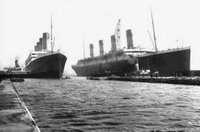Titanic Conspiracy?
Book alleges White Star sister ship-swapping scam
 A book published in 1995 claims the White Star Line swapped Titanic and her nearly identical sister ship, Olympic as part of an elaborate insurance scam. In their 262-page book, Robin Gardiner and Dan Van Der Vat make the case for their conspiracy theory, but it is a thin case indeed.
A book published in 1995 claims the White Star Line swapped Titanic and her nearly identical sister ship, Olympic as part of an elaborate insurance scam. In their 262-page book, Robin Gardiner and Dan Van Der Vat make the case for their conspiracy theory, but it is a thin case indeed.As we know from the historical record, Titanic's older sister ship Olympic (on left side of picture) had a bad run of luck since her maiden voyage in 1911, when she nearly sank a tugboat while docking in New York. A few months later she collided with the cruiser H.M.S. Hawke and suffered significant damage to her stern. She had to return to Belfast for repairs, thus delaying work on her new sister, Titanic. The Olympic was damaged again in March 1912 when she lost a propeller blade.
The authors contend that White Star, stung by heavy losses and still in litigation over the Hawke incident, simply used the March 1912 meeting of the sister ships to exchange one for the other. As the theory goes, Olympic became Titanic and merely had to undergo a single day of sea trials before setting out on a maiden voyage that, as the owners planned, would meet with disaster. This plan would rid the line of the damaged and already costly Olympic. The insurance money would then help the line try to make profits with the Olympic (Titanic in disguise) and the soon to be launched Gigantic. But, as the book goes on, Captain Smith in his recklessness hit an iceberg too soon and the ship sank before rescuers could reach her.
The theory has more holes than the iceberg-damaged Titanic herself. By March 1912 the Olympic and Titanic were significantly different in internal design and it would not be simply of matter of exchanging nameplates as the authors suggest. The book does make for fascinating reading and raises interesting questions. The conclusions reached by the authors, however, simply don't hold water.


1 Comments:
Well, alrighty then...
Post a Comment
<< Home